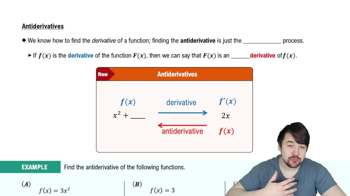Table of contents
- 0. Functions7h 52m
- Introduction to Functions16m
- Piecewise Functions10m
- Properties of Functions9m
- Common Functions1h 8m
- Transformations5m
- Combining Functions27m
- Exponent rules32m
- Exponential Functions28m
- Logarithmic Functions24m
- Properties of Logarithms34m
- Exponential & Logarithmic Equations35m
- Introduction to Trigonometric Functions38m
- Graphs of Trigonometric Functions44m
- Trigonometric Identities47m
- Inverse Trigonometric Functions48m
- 1. Limits and Continuity2h 2m
- 2. Intro to Derivatives1h 33m
- 3. Techniques of Differentiation3h 18m
- 4. Applications of Derivatives2h 38m
- 5. Graphical Applications of Derivatives6h 2m
- 6. Derivatives of Inverse, Exponential, & Logarithmic Functions2h 37m
- 7. Antiderivatives & Indefinite Integrals1h 26m
- 8. Definite Integrals3h 25m
7. Antiderivatives & Indefinite Integrals
Antiderivatives
Problem 4.2.38
Textbook Question
Find all functions whose derivative is f'(x) = x + 1.
 Verified step by step guidance
Verified step by step guidance1
Recognize that to find the functions whose derivative is given, we need to perform the process of integration on the derivative f'(x) = x + 1.
Set up the integral: f(x) = ∫(x + 1) dx, which means we will integrate the expression x + 1 with respect to x.
Apply the power rule of integration to each term: for the term x, the integral is (1/2)x^2, and for the constant term 1, the integral is x.
Combine the results of the integration: f(x) = (1/2)x^2 + x + C, where C is the constant of integration that represents any constant value that could be added.
Conclude that the general solution for the function f(x) is f(x) = (1/2)x^2 + x + C, where C can be any real number.
Recommended similar problem, with video answer:
 Verified Solution
Verified SolutionThis video solution was recommended by our tutors as helpful for the problem above
Video duration:
2mPlay a video:
Was this helpful?
Related Videos
Related Practice





